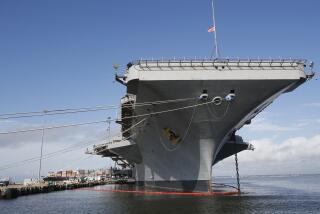Navy Yard shooterâs personnel report left out gun-related details
WASHINGTON â Washington Navy Yard shooter Aaron Alexis obtained a secret-level security clearance after a federal personnel report failed to mention that a 2004 arrest involved a firearm, the Navy said Monday.
A senior Navy official told reporters the service learned of the incidentâs violent nature only after Alexis had shot 12 people to death at the Washington Navy Yard last week and was himself fatally shot by police.
The Office of Personnel Management knew of Alexisâ Seattle arrest because of a fingerprint check when he joined the Navy Reserve in 2007 and interviewed him about it, the official said. Alexis had not disclosed the offense on his security questionnaire.
Alexis said that he had an altercation with a man doing construction work near his home and that the men had been âtaking retaliatory action toward each otherâs parked cars,â according to the investigative document that the personnel office gave to the Navy. Alexis said the construction worker had put a foreign substance in Alexisâ gas tank, and Alexis retaliated by âdeflating the male personâs tires,â according to the report.
That account âreads very different from the police account of what took place that day,â the senior official said. The Seattle police report says Alexis shot out the tires and was charged with malicious mischief, the official said.
Mondayâs disclosure revealed another in a chain of missed opportunities by the Navy and Alexisâ civilian employer â a military contractor â to come to grips with his violent tendencies and apparent mental illness. Alexis had complained that he was hearing voices and being bombarded by microwaves. Because of his job, which required a security clearance, he had a valid ID card that allowed him to enter the Navy Yard.
âThe summary of the Seattle incident that was provided to [the Navy] makes no reference to firearms, makes no reference to a gunshot ... makes no reference to firing into the air,â the Navy official said. The Navy provided access to the briefing on condition that the official not be identified.
The personnel office said Seattle police would not provide records on the 2004 incident. The office interviewed Alexis, who did not say that a weapon was involved. The personnel office said it could not force police departments to cooperate.
The Navy cleared Alexis based on all the information it had, the senior official said, and there is no way to know âhow they would have adjudicated knowing the events we know now. In a vacuum looking back, what we do know is that the events suggest very different activity.â
The construction worker did not press charges and the case was dismissed, the personnel office told the Navy.
Sometimes personnel office investigations include police documents, the Navy official said, but in this case the report sent to the Navy did not.
A recent memo sent to Navy Secretary Ray Mabus from Assistant Navy Secretary Juan M. Garcia included a recommendation that all personnel office investigative reports include âany available police documents related to the subject being investigated for clearance eligibility.â The recommendation has been sent to Defense Secretary Chuck Hagel.
On his security clearance form, Alexis answered ânoâ to questions about whether he had been charged with or convicted of a felony, and ânoâ to whether he had been arrested by any law enforcement official in the last seven years. The personnel report said Alexis said he did not disclose information about his 2004 arrest because the charge was dismissed and he was told by his attorney that it would be removed from his record.
Alexis was found to be eligible for the security clearance in March 2008 after the Navy reviewed the personnel investigation. The only concern was Alexisâ credit history, according to a timeline released by the Navy. His clearance was valid for 10 years.
In September 2008, Alexis was arrested in DeKalb County, Ga., on suspicion of disorderly conduct and jailed for two nights, resulting in an unauthorized absence. The Navy gave Alexis an administrative punishment.
In July 2009, he was punished again for being âdrunk and disorderly,â according to the timeline. But there was no police involvement, and Alexis successfully appealed the punishment, which was removed from his record.
In September 2010, he was arrested in Fort Worth for discharging a firearm in his home after an altercation with a neighbor. Alexis told police the gun accidentally went off as he was cleaning it. No charges were filed.
After the Fort Worth incident, Alexisâ commander began the process âto administratively separate him from the Navy,â according to the timeline. But when Alexis was not charged, the matter was dropped.
Alexis left the Navy three months later with an honorable discharge.
More to Read
Sign up for Essential California
The most important California stories and recommendations in your inbox every morning.
You may occasionally receive promotional content from the Los Angeles Times.










